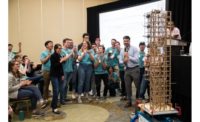To stimulate creativity among the minds of the next generation of architects, and to help address the shortage of quality affordable housing, the nationally regarded, award-winning architecture and master-planning firm The Architectural Team, Inc., has sponsored "Soft Living," a studio course and student design competition at the Boston Architectural College (BAC). This is the second year The Architectural Team has served as sponsor.
Soft Living invites undergraduate and graduate architecture students to envision the future of Boston through an “open ideas design competition” focused on approaches to enhance the vitality and impact of social, affordable, and adaptable housing prototypes needed for the future in downtown Boston. The coursework investigates modernist concepts of housing superblocks proposed by notables such as Archigram and Buckminster Fuller, with a design competition developed by The Architectural Team (TAT) in collaboration with BAC faculty. This year's program sets the stage for the course and competition to become an annual tradition. TAT sponsored the first such competition last year, in recognition of the firm’s 40-plus years since its founding.
The sponsoring firm's cofounder and managing principal, Robert J. Verrier, FAIA, also former president of the BAC’s Alumni Board, remarks, “Through competitions like Soft Living, we're building on our belief that engaging students in creative and collaborative reallife problem solving efforts can help generate innovative, sustainable and affordable living environments for all people. We're challenging student architects to transform Boston's dense urban landscape into a supportive environment that also demonstrates a sensitivity to Boston's architectural heritage, and the importance of that heritage to people in the region."
The Challenge: Affordable Green Housing
Among the parameters set forth by the BAC and TAT for this fall's course and competition is the use of prefabricated architectural solutions for the creation of affordable living environments. Instructors, sponsors and organizers hope the challenge will encourage students to develop new problem solving skills, and a greater understanding of the social behaviors that result from architectural decisions.
“The competition’s spirit and program will focus on encouraging multidisciplinary, imaginative ideas for our urban future,” Verrier adds. "We're thrilled that The Architectural Team has committed to sponsor the studio competition again this year," remarks Kyle Sturgeon, BAC's director of Advanced Architecture Studios & Technology Management. "The firm's leadership has demonstrated a commitment to educating emerging generations of creative and socially committed designers."
Sturgeon notes that the firm's commitment goes beyond its monetary sponsorship to support the Soft Living program and provide cash awards to the three finalists. In addition, The Architectural Team's senior project managers, Gary Kane, AIA and Andrew Stebbins, AIA are participating in the program through numerous student design reviews. Kane and Stebbins coordinate the reviews with course instructors Juliet Chun, a designer with Leers Weinzapfel Associates, and Jared Ramsdell, LEED AP, associate at Touloukian Touloukian, Inc. and an assistant instructor at Harvard Graduate School of Design.
"Juliet and Jared expressed that having senior TAT representatives participate in critiques and review sessions has proven to be a valuable learning moment for the students, and a true pleasure for all," Sturgeon confirms.
Structured to encourage high-level sustainable thinking, Soft Living's overarching goal is to demonstrate that architecture can multi-task, performing functions beyond those conventionally associated with residential buildings.
"Although proposals should be technologically feasible, they may also suggest non-traditional architectural visions of a sustainable residential future," says TAT Senior Project Manager Gary Kane, AIA.
"Accordingly," adds Kane, "design submissions must be environmentally responsible while fostering inventive conceptual living solutions respectful of the past, suitable for today and flexible enough for the future."
Verrier concurs: "Our work in Boston and beyond frequently calls for striking a balance between innovation and preservation. We want to see Boston's future architects grapple with this challenge. How do you incorporate pre-fabricated architectural elements into a design that reflects both Boston's future and its dearly held traditions? How do you make such a design both sustainable and affordable, not to mention socially responsible?"
Building Boston's Future, Preserving Its Past
The BAC Soft Living course competition reflects the four decades of work by The Architectural Team that has dramatically developed and revitalized numerous Boston neighborhoods with a broad range of new buildings and area plans.
Most recently, the firm designed The Kensington, a major new luxury 27 story, 381 unit, high-rise apartment building that opened in October at the confluence of Boston’s financial district, theatre district and Chinatown. Other recent projects include The Homes at Old Colony in South Boston, involving the redevelopment of one of the country’s old and most distressed public housing developments into a 285-unit sustainable multifamily housing community, and the Baker Chocolate Factory complex—an historic adaptive reuse development that was 25 years in the making, and involved converting eight existing mill buildings into 318 units of mixed-income housing.
TAT is currently at work on the last phase of a major historic preservation/adaptive reuse project at Boott Mills in Lowell, MA, which will create new commercial and residential space within iconic, overwhelmingly inactive, industrial buildings. The firm's work on preservation and adaptive reuse projects like Baker Chocolate
and Boott Mill often precipitates the urban revitalization of the surrounding areas, and generates new commercial activity in the form of restaurants, shopping areas, retail shops and luxury residential developments. Students in the Soft Living studio at BAC are encouraged to consider the economic impact of their designs.
The course concludes in December, after students have finalized their proposals and presented them to a jury comprised of BAC faculty and local architects. Winners will be announced shortly thereafter.
“Our motivation for engaging students is practical," says Verrier. "Students learn by doing. When we mentor, we shape a new generation of practitioners by transferring our knowledge and our passions, and sharing expertise that spans the entire process of creating safe, high-quality and affordable living environments."













